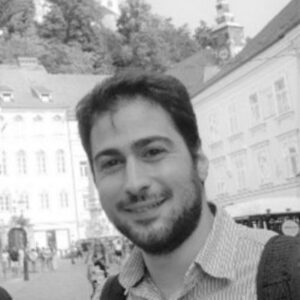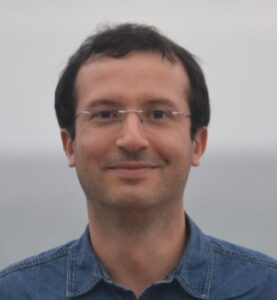HPSR 2023 Tutorial Lineup
- An Overview Of A Distributed Post-5G Network Architecture Within The EU SLICES-RI Research Infrastructure
- Introduction To Networking Technologies For High-Performance Computing
- Network Slicing For 6G: Technics, Standards, And Applications
- Network Softwarization At The Edge With SD-WAN
- The Role Of Data Engineering In Network Automation
An Overview Of A Distributed Post-5G Network Architecture Within The EU SLICES-RI Research Infrastructure
Abstract
We provide an overview of a blueprint for a disaggregated real-time post-5G network architecture that can be deployed on commodity networking and computing equipment. This activity is part of the European SLICES-RI research infrastructure and constitutes a distributed experimental post-5G playground for academic research purposes to be deployed across several EU countries. The blueprint is meant to be reproducible and to evolve in a collaborative manner. It makes use of open-source solutions such as SD-Fabric, Aether, OpenAirInterface, Nephio and others. The tutorial focuses on key networking components such as software-defined edge fabric, P4-based switching implementing the 5G user-plane function (UPF), cloud-native 5G radio-access (RAN) and core network functions (5GC), O-RAN near real-time RAN intelligent controllers (nRT-RIC), O-RAN Open-fronthaul interfaces and multi-cluster orchestration solutions. The tutorial will demonstrate live deployment and operation of a radio-edge site in Sophia Antipolis, France making use of some of the above technologies.
Speakers
Professor Raymond KNOPP received his PhD degree in Communication Systems from the Swiss Federal Institute of Technology (EPFL), Lausanne in 1997. His current research and teaching interests are in the area of digital communications, software radio architectures, and implementation aspects of signal processing systems and real-time networking protocols. He is currently head of the Communication Systems Department at EURECOM, Sophia Antipolis, France. He is a leading figure in the OpenAirInterface (OAI) Community and has been instrumental in making open software for Radio Access Networks a reality through contributions over two decades. He is one of the very first and one of the most significant contributors to the OAI codebase. He was elected as the President of the OpenAirInterface Software Alliance (OSA), a non-profit organization federating the OAI and Mosaic5G codebases in December 2018.
Professor Adlen Ksentini is a professor in the Communication Systems Department of EURECOM. He is leading the Network softwarization group activities related to Network softwarization, 5G/6G, and Edge Computing. Adlen Ksentini’s research interests are Network Sofwerization and Network Cloudification, focusing on topics related to network virtualization, Software Defined Networking (SDN), and Edge Computing for 5G and 6G networks. He has been involved in several H2020 EU projects on 5G, such as 5G!Pagoda, 5GTransformer, 5G!Drones and MonB5G. He is interested in the system and architectural issues but also in algorithms problems related to those topics, using Markov Chains, Optimization algorithms, and Machine Learning (ML). Adlen Ksentini has given several tutorials in IEEE international conferences, IEEE Globecom 2015, IEEEE CCNC 2017/2018/2023, IEEE ICC 2017, IEEE/IFIP IM 2017, IEEE School 2019. Adlen Ksentini is a member of the OAI board of directors, where he is in charge of OAI 5G Core Network and O-RAN management (O1, E2) for OAI RAN activities.
Dr. Damien Saucez is a researcher at Inria Sophia Antipolis since 2014 where he was previously post-doc since 2011. From October 2019 to October 2020 he was network specialist at Safran Electrical and Power in Toulouse, France, working on the design of high speed deterministic networks for aircrafts. He received his master degree in Computer Science engineering from Universitée catholique de Louvain in 2007 and his Ph.D. thesis entitled Mechanisms for Interdomain Traffic Engineering with LISP from the same university in 2011, under the supervision of Prof. Olivier Bonaventure. His current research interest is in using cellular technologies for mission critical networks. He is actively working to promote reproducibility in research by leading the ACM SIGCOMM 2017 Reproducibility Workshop and by chairing the ACM SIGCOMM Artifacts Evaluation Committee.
Dr. Nikos Makris is a Postdoctoral Researcher with the Department of Electrical and Computer Engineering, University of Thessaly, Greece and the Centre for Research and Technology Hellas (CERTH). He received his bachelor degree in 2011, a Master’s degree in Computer Science and Communications in 2013, and his Ph.D. in ECE in 2020 from the same department. In the period 2020-2021 he worked as a Postdoctoral Associate in the Dept. of Electrical Engineering, Yale University, USA. Since 2011, he has been participating in several EU- and NSF-funded collaborative research projects. His research interests include experimentally driven research with several radio access technologies (WiFi, LTE, 5G-NR), conducted under real environment settings, the control- and user-plane disaggregation of base station units, Multi-access Edge Computing and NFV orchestration using open-source platforms.
Introduction To Networking Technologies For High-Performance Computing
Abstract
InfiniBand (IB), High-speed Ethernet (HSE), RoCE, Omni-Path, EFA, Tofu, Slingshot, and Aquila technologies are generating a lot of excitement towards building next generation High-End Computing (HEC) systems including clusters, data- centers, file systems, storage, cloud computing and Big Data (Hadoop, Spark, HBase and Memcached) environments. This tutorial will provide an overview of these emerging technologies, their offered architectural features, their current market standing, and their suitability for designing HEC systems. It will start with a brief overview of IB, HSE, RoCE, Omni- Path, EFA, Tofu, Slingshot, and Aquila. In-depth overview of the architectural features of IB, HSE (including iWARP and RoCE), and Omni-Path, their similarities and differences, and the associated protocols will be presented. An overview of the emerging NVLink, NVLink2, NVSwitch, Slingshot, Tofu, Aquila architectures will also be given. Next, an overview of the OpenFabrics stack which encapsulates IB, HSE, and RoCE (v1/v2) in a unified manner will be presented. An overview of libfabrics stack will also be provided. Hardware/software solutions and the market trends behind these networking technologies will be highlighted. Sample performance numbers of these technologies and protocols for different environments will be presented. Finally, hands-on exercises will be carried out for the attendees to gain first-hand experience of running experiments with high-performance networks.
Speakers
Dhabaleswar K. (DK) Panda is a Professor of Computer Science and Engineering and University Distinguished Scholar at the Ohio State University. His research interests include parallel computer architecture, high-performance networking, Exascale computing, Big Data, Deep Learning, programming models, accelerators, high-performance file systems and storage, virtualization, and cloud computing. He has published over 500 papers in major journals and international conferences related to these research areas. Dr. Panda and his research group members have been doing extensive research on modern networking technologies including InfiniBand, High-Speed Ethernet, RDMA over Converged Enhanced Ethernet (RoCE), Omni-Path, and EFA. Dr. Panda and his team have been actively working on high-performance MPI and PGAS libraries (http://mvapich.cse.ohio-state.edu), Deep Learning libraries (http://hidl.cse.ohio-state.edu) and Big Data libraries (http://hibd.cse.ohio-state.edu). Dr. Panda has served (or serving) as Program Chair/Co-Chair/Vice Chair of many international conferences. He is an IEEE Fellow and a member of ACM. More details are available at http://www.cse.ohio-state.edu/~panda.
Hari Subramoni received the Ph.D. degree in Computer Science from The Ohio State University, Columbus, OH, in 2013. He is an assistant professor in the Department of Computer Science and Engineering at the Ohio State University, USA. His research interests include high-performance interconnects and protocols, parallel computer architecture, network-based computing, exascale computing, network topology-aware computing, QoS, power-aware LAN-WAN communication, fault tolerance, virtualization, cloud computing, and deep learning. He has published over 120 papers in international journals and conferences related to these research areas. He has been actively involved in various professional activities in academic journals and conferences. Recently, Dr. Subramoni is doing research and working on design and development for of MVAPICH2 (High-Performance MPI over InfiniBand, iWARP and RoCE) and MVAPICH2-X (Hybrid MPI and PGAS (OpenSHMEM and UPC)) software packages. More details about Dr. Subramoni are available at https://web.cse.ohio-state.edu/~subramoni.1/.
6G Network Slicing Technics: Recent Advances, Standards, and Challenges
Abstract
6G is designed to achieve breakthroughs in mobile networks, and is expected to have features such as seamless global coverage, full virtualization, and ubiquitous intelligence. More application scenarios with specific capabilities will emerge, which urgently require customized end-to-end service provisioning. Network slicing is widely recognized as a key enabling technology for 6G, which can divide the physical network into multiple logical networks as needed, changing the network form from “one-size-fits-all” to “one-size-per-service” to meet differentiated performance metrics and service requirements. Although the network slicing concept has been explored to some extent in 5G, it will be fully extended and perfected in 6G with the combination of ubiquitous intelligence and various innovative application scenarios. This tutorial comprehensively reviews the research work on 6G network slicing technics from three aspects: recent advances, standards, and challenges. Slicing technics are the basis of end-to-end logical isolation and service provisioning, which involves many technical domains such as access network, transport network, core network, and slicing management system. We first introduce key recent advances in slicing technics according to these different domains. In particular, we emphasize the great potential of artificial intelligence techniques for network slicing. In addition, cross-domain and cross-vendor standards can provide guidance for slicing technics, which is necessary for the wide application and commercialization of 6G network slicing. Finally, we highlight the challenges faced by network slicing and envision its future development.
Speakers
Jiadai Wang (S’18, M’22) is currently an associate professor with the School of Cybersecurity, Northwestern Polytechnical University, Xi’an, China. She has authored or coauthored more than 20 peer-reviewed papers in many high-quality publications, including prestigious IEEE journals and conferences. Her research interests cover network slicing, software-defined networking, IoT, connected vehicles, and 5G/6G communications.
Jiajia Liu (SM’15) is a full professor (Vice Dean) at the School of Cybersecurity, Northwestern Polytechnical University, and was a Full Professor (2013-2018) at the School of Cyber Engineering, Xidian University. He has published more than 200 peer-reviewed papers in many high quality publications, including prestigious IEEE journals and conferences. He received 2020 IEEE ComSoc Best YP Award in Academia, 2019 IEEE VTS Early Career Award, IEEE ComSoc Asia-Pacific Outstanding Young Researcher Award in 2017, the Best Paper Awards from many international conferences including IEEE flagship events, such as IEEE GLOBECOM in 2019 and 2016, IEEE WiMob in 2019, IEEE WCNC in 2012 and 2014, IEEE IC-NIDC in 2018. His research interests cover a wide range of areas including wireless and mobile ad hoc networks, space-air-ground integrated networks, intelligent and connected vehicles, mobile/edge/cloud computing and storage, Internet of things security. He is the Chair of IEEE IOT-AHSN TC, and is a Distinguished Lecturer of the IEEE Communications Society and Vehicular Technology Society.
Network Softwarization At The Edge With SD-WAN
Abstract
This tutorial addresses the Software-Defined Wide Area Network (SD-WAN) technology, which has recently conquered the enterprise-networking market all over the world. SD-WAN is regarded as very promising for the next-generation WANs, especially by the Communication Service Providers (CSPs) as a new highly effective solution they can offer to their customers. SD-WAN brings the advantages of SDN to the WAN, applying the concept of separation among data and control plane. The main goal is to provide dynamic, fast and reliable interconnections between the sites of an organization, such as headquarters, data-centers, branch offices, that are geographically distributed over a wide area. A communication infrastructure with a national or international or even global extension can thus be provided to the tenants as an overlay network over heterogeneous public WANs. SD-WAN reduces the costs, but has to preserve the same quality of service of alternative, more expensive technologies, such as MPLS. We will present a detailed overview of SD-WAN by addressing the most important use cases, such as enterprise branch-to-headquarter and headquarter-to-data-center switching interconnection. In particular, we will focus on the network architecture requirements in order to obtain an agile and efficient control plane. Afterwards, we will describe the decision techniques that can be implemented inside the SD-WAN controller, making a comparison between traditional and Machine-Learning solutions. During the tutorial we will displaysome testbeds and present a live demo.
Speakers
Sebastian Troia is an assistant professor at the Dipartimento di Elettronica Informazione e Bioingegneria, Politecnico di Milano (Milan, Italy). He received his Master degree in Telecommunication Engineering at Politecnico di Milano (Italy) in 2017 and his Ph.D. degree (cum laude) in Information Technology at the same university in 2020. Currently he is an Assistant Professor with the Department of Electronics, Information and Bioengineering (DEIB) at Politecnico di Milano and a Fulbright research scholar with the University of Texas at Dallas (USA). From 2018, he became a partner with SWAN networks, a spin-off of Politecnico di Milano developing network orchestration and advanced algorithms for SDN and SD-WAN based networks. His current research interests are in the field of edge network softwarization and Machine Learning for communication networks. His activity regards the development of intelligent control and orchestration plane architectures for SDN and SD- WAN in multi-layer (optical and IP) network scenarios. He was involved in different European Projects: H2020 Metro-Haul, NGI Atlantic and FP7 Marie Curie MobileCloud, and served as editor for the ITU Focus Group on Machine Learning for Future Networks including 5G (FG-ML5G). He has co-authored more than 40 publications in international journals, conferences and book chapters, with a focus on Machine-Learning for SDN, SD-WAN and NFV. I am a reviewer for several international journals, and a member of the Technical Program Committee for international conferences and workshops including IEEE ICC and IEEE GLOBECOM. I have been also a member of the Organizing Committee for IEEE HPSR 2019, DRCN 2020 and 2021, and IEEE NetSoft 2022. I am the co-organizer and general co-chair of the second edition of the Edge Network Softwarization (ENS) workshop, which will be held in conjunction with IEEE NetSoft 2023 in Madrid, Spain.
Guido Maier is an associate professor at the Dipartimento di Elettronica Informazione e Bioingegneria, Politecnico di Milano (Milan, Italy). He received his Laurea degree in Electronic Engineering at Politecnico di Milano (Italy) in 1995 and his Ph.D. degree in Telecommunication Engineering at the same university in 2000. Until February 2006 he has been a researcher at CoreCom (research consortium supported by Pirelli in Milan, Italy), where he achieved the position of Head of the Optical Networking Laboratory. On March 2006 he joined the Politecnico di Milano as Assistant Professor. In 2015 he became Associate Professor. His main areas of interest are: optical network modeling, design, and optimization; SDN orchestration and control-plane architectures; SD-WAN and NFV. He is a co-author of more than 150 papers in the area of Networking published in international journals and conference proceedings (h-index 28) and 6 patents. He is was involved in industrial and European research projects. Currently, he is the PI of the Italian research project WatchEDGE (RESTART framework, funded by NextGenerationEU). In 2016 he co-founded the start-up SWAN networks, spin-off of Politecnico di Milano. He is an editor of the journal Optical Switching and Routing, guest editor of the IEEE Open Journal of the Communications Society, TCP Chair of IEEE HPSR 2019, General Chair of DRCN 2020, DRCN 2021, and IEEE NetSoft 2022, and TPC member in many international conferences. He is a member of the Scientific Committee of CoRiTel (Italian research consortium of Ericsson, Politecnico di Milano, and other partners). He is a Senior Member of the IEEE Communications Society.
The Role Of Data Engineering In Network Automation
Abstract
To address the complex issues that larger and highly integrated networks face in the design, analysis, deployment and management phases, recent advances in data science and engineering technologies in both academia and industry have spurred the adoption of various Artificial Intelligence (AI)/Machine Learning (ML) platforms and frameworks in telecommunication network infrastructures. In this tutorial, we aim to provide a comprehensive and thorough overview of the recent advances in data engineering frameworks and link the capabilities of the data engineering ecosystem with a possible connection to future telecommunication systems in the context of network management and orchestration. Some special features of this tutorial are: a clear link between the data engineering ecosystem (including data connection, data ingestion, data processing & analysis, data storage, data monitoring & visualization and data management & orchestration frameworks) and recent developments in networking, an overview of standardization efforts in network management and orchestration and how these can be related to data engineering frameworks, the relationship to data science frameworks, ML platforms used in the industry, and related data engineering use cases for telecommunications networks will be discussed. Two examples on log management in NFV service orchestration and AI/ML-driven scaling of digital service will also be demonstrated.
Speakers
Engin Zeydan received the PhD degree in February 2011 from the Department of Electrical and Computer Engineering at Stevens Institute of Technology, Hoboken, NJ, USA. Since November 2018, he has been with the Communication Networks Division of the CTTC working as a Senior Researcher. He was a part-time instructor at Electrical and Electronics Engineering department of Ozyegin University Istanbul, Turkey between January 2015 and June 2018. His research areas include data engineering/science for telecommunication networks.
Josep Mangues-Bafalluy received the PhD degree in Telecommunications in 2003 from the Technical University of Catalonia (UPC). He is Senior Researcher and Head of the Services as Networks (SAS) Research Unit of the CTTC. He has given keynotes at conferences/workshops (MONAMI 2015, Mobislice 2020). His research interests include SDN and NFV applied to next-generation mobile networks and data science/engineering- and AIML-based network automation.










